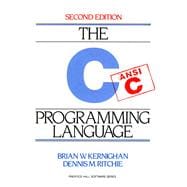
Note: Supplemental materials are not guaranteed with Rental or Used book purchases.
Purchase Benefits
What is included with this book?
Brian W. Kernighan works in the Computing Science Research Center at Bell Laboratories, Lucent Technologies. He is Consulting Editor for Addison-Wesley's Professional Computing Series and the author, with Dennis Ritchie, of The C Programming Language.
Dennis Ritchie was a computer scientist notable for his influence on ALTRAN, B, BCPL, C, Multics, and Unix.
| Preface | ix | (2) | |||
| Preface to the First Edition | xi | ||||
| Introduction | 1 | (4) | |||
|
5 | (30) | |||
|
5 | (3) | |||
|
8 | (5) | |||
|
13 | (1) | |||
|
14 | (1) | |||
|
15 | (7) | |||
|
22 | (2) | |||
|
24 | (3) | |||
|
27 | (1) | |||
|
28 | (3) | |||
|
31 | (4) | |||
|
35 | (20) | |||
|
35 | (1) | |||
|
36 | (1) | |||
|
37 | (3) | |||
|
40 | (1) | |||
|
41 | (1) | |||
|
41 | (1) | |||
|
42 | (4) | |||
|
46 | (2) | |||
|
48 | (2) | |||
|
50 | (1) | |||
|
51 | (1) | |||
|
52 | (3) | |||
|
55 | (12) | |||
|
55 | (1) | |||
|
55 | (2) | |||
|
57 | (1) | |||
|
58 | (2) | |||
|
60 | (3) | |||
|
63 | (1) | |||
|
64 | (1) | |||
|
65 | (2) | |||
|
67 | (26) | |||
|
67 | (4) | |||
|
71 | (2) | |||
|
73 | (7) | |||
|
80 | (1) | |||
|
81 | (2) | |||
|
83 | (1) | |||
|
83 | (1) | |||
|
84 | (1) | |||
|
85 | (1) | |||
|
86 | (2) | |||
|
88 | (5) | |||
|
93 | (34) | |||
|
93 | (2) | |||
|
95 | (2) | |||
|
97 | (3) | |||
|
100 | (4) | |||
|
104 | (3) | |||
|
107 | (3) | |||
|
110 | (3) | |||
|
113 | (1) | |||
|
113 | (1) | |||
|
114 | (4) | |||
|
118 | (4) | |||
|
122 | (5) | |||
|
127 | (24) | |||
|
127 | (2) | |||
|
129 | (3) | |||
|
132 | (4) | |||
|
136 | (3) | |||
|
139 | (4) | |||
|
143 | (3) | |||
|
146 | (1) | |||
|
147 | (2) | |||
|
149 | (2) | |||
|
151 | (18) | |||
|
151 | (2) | |||
|
153 | (2) | |||
|
155 | (2) | |||
|
157 | (3) | |||
|
160 | (3) | |||
|
163 | (1) | |||
|
164 | (2) | |||
|
166 | (3) | |||
|
169 | (22) | |||
|
169 | (1) | |||
|
170 | (2) | |||
|
172 | (2) | |||
|
174 | (1) | |||
|
175 | (4) | |||
|
179 | (6) | |||
|
185 | (6) | |||
|
191 | (50) | |||
|
191 | (1) | |||
|
191 | (3) | |||
|
194 | (1) | |||
|
195 | (2) | |||
|
197 | (1) | |||
|
197 | (3) | |||
|
200 | (10) | |||
|
210 | (12) | |||
|
222 | (3) | |||
|
225 | (2) | |||
|
227 | (1) | |||
|
228 | (6) | |||
|
234 | (7) | |||
|
241 | (18) | |||
|
241 | (7) | |||
|
248 | (1) | |||
|
249 | (1) | |||
|
250 | (1) | |||
|
251 | (2) | |||
|
253 | (1) | |||
|
254 | (1) | |||
|
254 | (1) | |||
|
255 | (1) | |||
|
255 | (2) | |||
|
257 | (2) | |||
|
259 | (4) | |||
| Index | 263 |
The New copy of this book will include any supplemental materials advertised. Please check the title of the book to determine if it should include any access cards, study guides, lab manuals, CDs, etc.
The Used, Rental and eBook copies of this book are not guaranteed to include any supplemental materials. Typically, only the book itself is included. This is true even if the title states it includes any access cards, study guides, lab manuals, CDs, etc.